Site pages
Current course
Participants
General
MODULE 1. Fundamentals of Soil Mechanics
MODULE 2. Stress and Strength
MODULE 3. Compaction, Seepage and Consolidation of...
MODULE 4. Earth pressure, Slope Stability and Soil...
Keywords
LESSON 4. Classification of Soil
4.1 Classification Based on Grain size
In general, soils may be classified as coarse-grained (cohesionless) and fine-grained (cohesive) soil. The both coarse-grained and fine-grained soils can be further sub-divided based on their grain size. According to Indian Standard Soil Classification System (ISSCS), soil with particle size > 300 mm is called Boulder. Soil with particle size in between 300 mm to 80 mm is called Cobble. The soil is called Gravel if particle size is in between 80 mm to 4.75 mm. The gravel is sub-divided as Coarse Gravel (80 mm to 20 mm) and Fine Gravel (20 mm to 4.75mm). Soil with particle size in between 4.75 mm to 0.075 mm is called Sand. The sand is sub-divided as Coarse Sand (4.75 mm to 2.0 mm), Medium Sand (2.0 mm to 0.425 mm) and Fine Sand (0.425 mm to 0.075 mm). Soil with particle size less than 0.075 mm is called Fine-Grained soil (Silt or Clay) and soil with particle size in between 80 mm to 0.075 mm is called Coarse-Grained soil. However, soil with particle size less than 0.002 mm is called Clay and soil with particle size in between 0.075mm to 0.002 mm is called Silt.
4.2 The Unified Soil Classification System
The Unified Soil Classification System (USCS) originally developed by Casagrande (1948). According to this system, the symbols of the various soils are as: Gravel (G), Sand (S), Silt or Silty (M), Clay or Clayey (C), Organic (O), Peat (Pt), Well graded (W), Poorly graded (P).
The soil is called coarse-grained soil if 50% or more soil is retained on the 0.075mm sieve. If the 50% or more of the coarse fraction is retained on the 4.75mm sieve, the soil is called Gravel. On the other hand if 50% or more of the coarse fraction is passed through the 4.75mm sieve, the soil is called Sand. Various types of coarse-grained soils are classified as: GW (Well graded Gravel), GP (Poorly graded Gravel), SW (Well graded Sand), SP (Poorly graded Sand), SM (Silty Sand), GM (Silty Gravel), SC (Clayey Sand), and GC (Clayey Gravel). In case of well graded gravels and well graded sands, less than 5% soils pass 75m sieve. However, In case of poorly graded gravels and poorly graded sands very little or no fines are present.

Fig. 4.1. Plasticity chart as per Unified Soil Classification System (USCS).
The soil is called fine-grained soil if 50% or more soil is passed through 0.075 mm sieve. The fine-grained soils are classified based on plasticity chart (as shown in Figure 4.1). The soil has low plasticity (CL: Clay with low plasticity, ML: Silt with low plasticity) if the liquid limit of the soil is less than 50% and if the liquid limit of the soil is greater than 50% the soil has high plasticity (CH: Clay with high plasticity, MH: Silt with high plasticity). However, more than one group can be termed as boundary soils (like GW-GM: Well graded gravel mixed with silt).
4.3 Aashto Soil Classification System
According to the AASHTO soil classification system, the soils are classified based on the Group Index (GI) value which can be calculated as:
GI = 0.2 a + 0.005 ac + 0.01 bd
where
a is that part of the percent passing through the 75 m (0.075 mm) sieve greater than 35 and not exceeding 75, expressed as a positive whole number (range 1 to 40).
b is that part of the percent passing through the 75 m (0.075 mm) sieve greater than 15 and not exceeding 55, expressed as a positive whole number (range 1 to 40).
c is that part of liquid limit greater than 40 and not exceeding 60, expressed as a positive whole number (range 1 to 20).
d is that part of plasticity index greater than 10 and not exceeding 30, expressed as a positive whole number (range 1 to 20).
The group index should be rounded off to the nearest whole number. If the calculated group index value is negative, then it is taken as zero. A group index value equal to zero indicates a good subgrade material, whereas group index value equal to or greater than 20 indicates a very poor subgrade material.
4.4 Indian Standard Soil Classification System (ISSCS)
According to this system, the symbols of the various soils are as: Gravel (G), Sand (S), Silt or Silty (M), Clay or Clayey (C), Organic (O), Peat (Pt), Well graded (W), Poorly graded (P). To classify the fine-grained soil, plasticity chart (as shown in Figure 2) is used. The difference between the plasticity charts used for Unified Soil Classification System (USCS) and Indian Standard Soil Classification System (ISSCS) is that in USCS, the soil is classified as High Plasticity (if liquid limit >50%) or Low Plasticity (if liquid limit < 50%) soil, but in ISSCS, the soil is classified as High Plasticity (if liquid limit >50%) or Intermediate Plasticity (if liquid limit is in between 35% to 50%) or Low Plasticity (if liquid limit < 35%). For example, if a soil sample has liquid limit (wL) 45% and plasticity index (IP) 25, according to the Unified Soil Classification System (USCS) the point is above ‘A’ line (point A in Figure 4.1) and it is classified as CL. However, according to Indian Standard Soil Classification System (ISSCS) the point is also above ‘A’ line (point B in Figure 4.2), but it is classified as CI.
Figure 4.3 shows the flow chart to classify a soil according to the Indian Standard Soil Classification System. Figure 4.4 and Figure 4.5 show the classification of coarse-grained and fine-grained soil, respectively as per Indian Standard Soil Classification System.
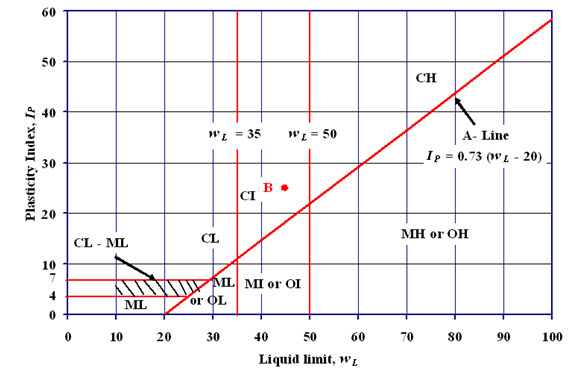
Fig. 4.2. Plasticity chart as per Indian Standard Soil Classification System
(ISSCS).
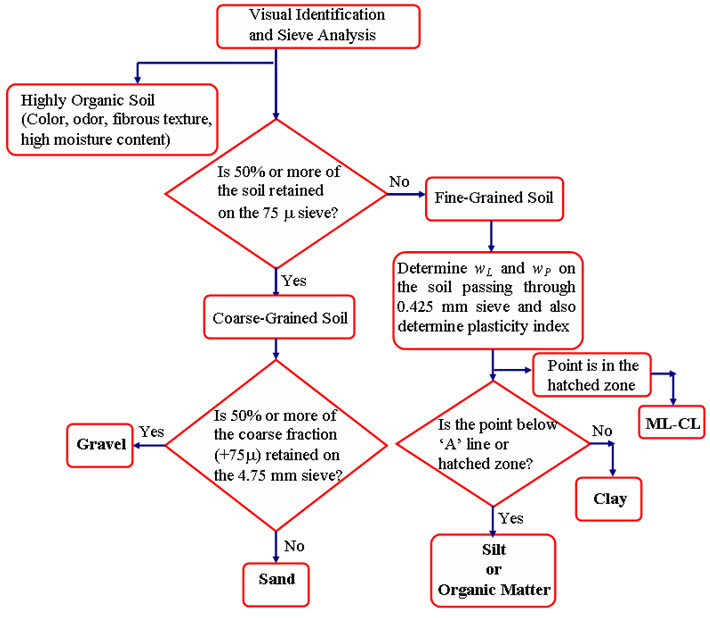
Fig. 4.3. Flow chart to classify soil (as per ISSCS).
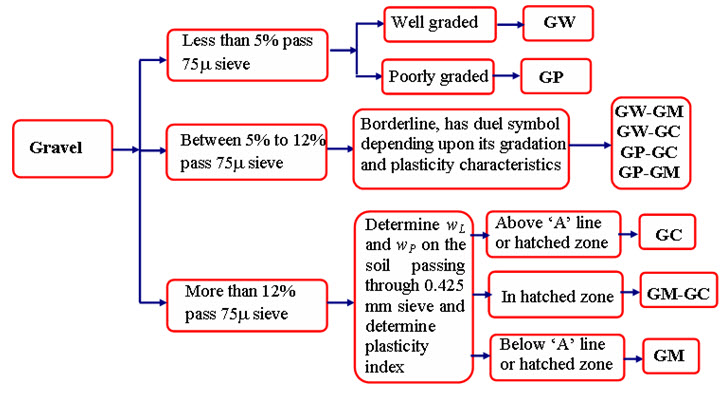
(a)
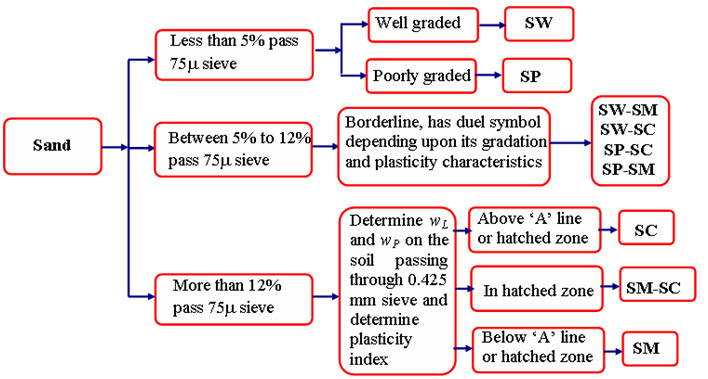
(b)
Fig. 4.4. Classification of coarse-grained soil: (a) Gravel (b) Sand (as per ISSCS).
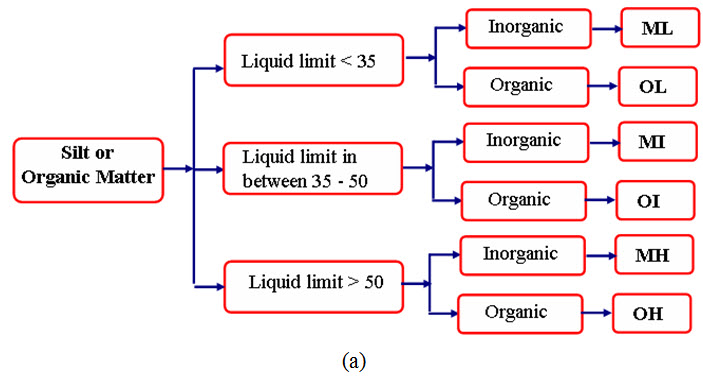
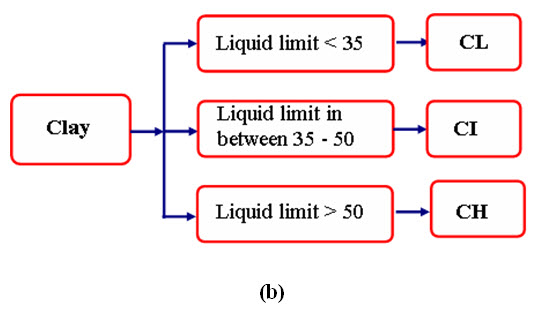
Fig. 4.5. Classification of fine-grained soil: (a) Silt or Organic matter (b) Clay (as per ISSCS).
References
Ranjan, G. and Rao, A.S.R. (2000). Basic and Applied Soil Mechanics. New Age International Publisher, New Delhi, India
Suggested Readings
Ranjan, G. and Rao, A.S.R. (2000) Basic and Applied Soil Mechanics. New Age International Publisher, New Delhi, India.
Arora, K.R. (2003) Soil Mechanics and Foundation Engineering. Standard Publishers Distributors, New Delhi, India.
Murthy V.N.S (1996) A Text Book of Soil Mechanics and Foundation Engineering, UBS Publishers’ Distributors Ltd. New Delhi, India.